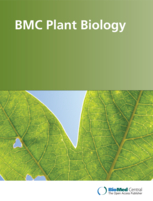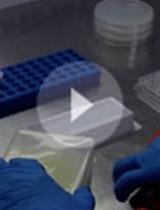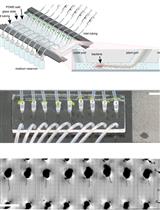- EN - English
- CN - 中文
Bean Pod Mottle Virus (BPMV) Viral Inoculation Procedure in Common Bean (Phaseolus vulgaris L.)
菜豆中豆荚斑驳病毒(BPMV)的接种步骤
发布: 2015年07月05日第5卷第13期 DOI: 10.21769/BioProtoc.1524 浏览次数: 18367
评审: Arsalan DaudiShyam SolankiMarisa Rosa
Abstract
Viral vectors derived from the Bean pod mottle virus (BPMV) were shown to be highly efficient tools for functional studies in soybean (Glycine max) and common bean (Phaseolus vulgaris) (Zhang et al., 2010; Diaz-Camino et al., 2011; Pflieger et al., 2013; Pflieger et al., 2014). Indeed, BPMV-derived vectors enable successful foreign gene expression analysis as well as virus-induced gene silencing (VIGS) but the delivery procedure of the viral vector into plants (i.e. primary inoculation) is a critical step. It can be achieved by various techniques such as Agrobacterium-mediated infiltration (agro-inoculation), mechanical inoculation of in vitro transcribed RNA, or biolistic delivery of infectious plasmid DNA (i.e. a DNA plasmid carrying a cDNA copy of the modified viral genome under the control of a 35S promoter). These delivery methods may be incompatible with large-scale functional studies (Pflieger et al., 2013). Here, we present the protocol for rapid, cheap and simple mechanical inoculation of BPMV vectors by direct rubbing of infectious plasmid DNA (direct DNA rubbing). Once infected plants are obtained, we used a classical protocol of mechanical inoculation using infected leaf sap to inoculate new healthy common bean plants (i.e. secondary inoculation).
Materials and Reagents
- Phaseolus vulgaris (P. vulgaris) seeds
Notes:- Seeds of common bean genotypes can be obtained from the Centro Internacional de Agricultura Tropical (CIAT, Colombia).
- ‘Black Valentine’ is recommended for primary inoculation to generate infected leaf sap used for further inoculation of any other genotypes. For secondary inoculation, any other genotype of interest can be used.
- Seeds of common bean genotypes can be obtained from the Centro Internacional de Agricultura Tropical (CIAT, Colombia).
- Vermiculite 1-4 mm (Agrena Rungis, catalog number: VERMOYS100 )
- Carborundum 0.037 mm (used as an abrasive) (VWR, catalog number: 22540.298 )
- Recombinant BPMV RNA1 plasmid (pBPMV-IA-R1M) (Zhang et al., 2010) (Note 1)
- Recombinant BPMV RNA2 plasmid (pBPMV-IA-V1, as a BPMV wild-type control) (Zhang et al., 2010) (Note 1)
- Recombinant BPMV RNA2 plasmid (pBPMV-GFP2) (green fluorescence protein) [as a gene expression positive control (Zhang et al., 2010) (Note 1)]
- Recombinant BPMV RNA2 plasmid, (pBPMV-PvPDS391bp) (phytoene desaturase) [as a VIGS positive control (Pflieger et al., 2014) (Note 1)]
- Miracloth (Calbiochem®, catalog number: 475855-1R )
- K2HPO4 (Sigma-Aldrich, catalog number: P3786 )
- KH2PO4 (Sigma-Aldrich, catalog number: P0662 )
- MilliQ water
- Absorbant paper 1500F (Argos, catalog number: 106 )
- Liquid nitrogen
- Qiagen kit “Plasmid Maxi Kit” (QIAGEN, catalog number: 12163 )
- Fertilizer Plant-Prod 14-12-32 (Puteaux SA)
- Fertilizer Fertiligo L (Fertil International SA)
- Nutritive solution (see Recipes)
- 0.1 M potassium phosphate buffer (see Recipes)
- 50 mM potassium phosphate buffer (see Recipes)
Equipment
- Greenhouse or growth chamber for plant growth
- Greenhouse or growth chamber for phytopathological tests (Note 2)
- Pipetmans (Gilson, model: p1000 , p200 , p100 , p20 and p10 ) and tips
- -20 °C refrigerator
- -80 °C refrigerator
- Vortex
- Plastic pots (7 x 7 x 6 cm pots and 20 cm diameter pots of 4 L)
- Growth chamber
- Latex gloves
- Surgical masks
- Microcentrifuge
- Eppendorf microfuge tube
- 1.5 ml microfuge tubes
- Mortar (9 cm diameter) and pestle (12 mm diameter)
- UV lamp for GFP detection (High intensity 100-Watt long-wave UV lamp, UVP®)
- UV face shield (Thermo Fisher Scientific, catalog number: 6355 )
Procedure
文章信息
版权信息
© 2015 The Authors; exclusive licensee Bio-protocol LLC.
如何引用
Pflieger, S., Blanchet, S., Meziadi, C., Richard, M. M. and Geffroy, V. (2015). Bean Pod Mottle Virus (BPMV) Viral Inoculation Procedure in Common Bean (Phaseolus vulgaris L.). Bio-protocol 5(13): e1524. DOI: 10.21769/BioProtoc.1524.
分类
植物科学 > 植物免疫 > 病害生物测定
微生物学 > 微生物-宿主相互作用 > 体内实验模型 > 植物
微生物学 > 微生物-宿主相互作用 > 病毒
您对这篇实验方法有问题吗?
在此处发布您的问题,我们将邀请本文作者来回答。同时,我们会将您的问题发布到Bio-protocol Exchange,以便寻求社区成员的帮助。
Share
Bluesky
X
Copy link













